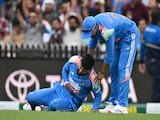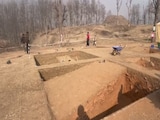New Delhi:
India today said it will test fire the over 5,000 km range nuclear-capable Agni-V surface to surface ballistic missile "within a year" that can strike any target in China and Pakistan.
"Agni-V is a 5,000-km-plus missile and we are planning to carry out its first test within a year. After Agni-III and Agni-V, as far as cities in China and Pakistan are concerned, there will be no target that we want to hit but can't hit," DRDO Chief V K Saraswat said on Wednesday, adding that the "missile was already out of the drawing boards."
The test-firing of the Agni-V missile will also help India to join the elite club on nations with the capability to produce Inter-Continental Ballistic Missiles (ICBMs). Saraswat said the missile would be capable of being launched from canisters, which will help it to be launched from multiple platforms. With certain modifications, canister launchers enable ballistic missiles to be fired from ships and other moving platforms.
Comparing the Agni-III with Chinese 2,500 km range DF-21 and DF-25, Agni programme Director Avinash Chander said in terms of "accuracy and technology-wise", the indigenous missiles were better than the ones in the neighbourhood. He added that Agni-V would be a three-stage missile and it was in the sub-systems testing phase.
"The missile will have composite rocket motors instead of metal rocket motors. That technology has been realised 90 per cent as we have already tested it and are fine-tuning it to meet our requirements. It is in the sub-systems testing stage," he said.
Chander said the Agni-V is a derivative of Agni-III and 60 per cent of it was ready and the rest will have to be developed. "Agni-V will be the first missile that will have a three-stage propulsion system. It will have the same warhead and navigation system as that of the Agni-III, has the same diameter of 2 meters and is only half a metre longer than it," he added.
Asked if the country was planning to develop missiles of longer ranges, the DRDO Chief said, "In last 15 years, DRDO and India have come to a level of maturity in missile technology that we can build missiles of any range in these classes of systems mobile, semi-mobile and static if we need that."
He added the range and lethality of missiles was based on the requirements projected by the security establishment and "whether you make a 5,000 kilometre class missile or a longer range missile, 99 per cent of the technology and building blocks of the two are common."
Commenting on the successful test-firing of the Agni-III on February 7, the DRDO chief V K Saraswat said the "development" phase of the missile was over and it was ready for induction into the armed forces. The DRDO Chief said looking at the class and capabilities of the Agni-III, "there is no need for us to build missiles and keep storing them. There is no need and there is no requirement." He said "building and storing" missiles had a tremendous impact on "efforts and resources" and it was better to have building blocks of technology ready and have the capability as and when required in the shortest possible time.
Asked why was the missile test-fired only four times before induction, he said India had made advancements in design and simulation capabilities and a limited number of tests were required to prove the system.
On the problems faced by the Agni-II and Agni-III during their earlier tests, Chander said, "we have a problem and we have identified it. In both the cases, it was the quality-related issue and we are working to address those issues." He said the Agni-III was capable of being launched from both rail and road launchers and was made up of composite material.
Chander said the missile will be now tested by the armed forces as users and will be manufactured by Bharat Dynamics Limited in Hyderabad. The missile has been built with support of over 150 industrial partners, 20 DRDO laboratories and 20 other national level institutes, he added.
"Agni-V is a 5,000-km-plus missile and we are planning to carry out its first test within a year. After Agni-III and Agni-V, as far as cities in China and Pakistan are concerned, there will be no target that we want to hit but can't hit," DRDO Chief V K Saraswat said on Wednesday, adding that the "missile was already out of the drawing boards."
The test-firing of the Agni-V missile will also help India to join the elite club on nations with the capability to produce Inter-Continental Ballistic Missiles (ICBMs). Saraswat said the missile would be capable of being launched from canisters, which will help it to be launched from multiple platforms. With certain modifications, canister launchers enable ballistic missiles to be fired from ships and other moving platforms.
Comparing the Agni-III with Chinese 2,500 km range DF-21 and DF-25, Agni programme Director Avinash Chander said in terms of "accuracy and technology-wise", the indigenous missiles were better than the ones in the neighbourhood. He added that Agni-V would be a three-stage missile and it was in the sub-systems testing phase.
"The missile will have composite rocket motors instead of metal rocket motors. That technology has been realised 90 per cent as we have already tested it and are fine-tuning it to meet our requirements. It is in the sub-systems testing stage," he said.
Chander said the Agni-V is a derivative of Agni-III and 60 per cent of it was ready and the rest will have to be developed. "Agni-V will be the first missile that will have a three-stage propulsion system. It will have the same warhead and navigation system as that of the Agni-III, has the same diameter of 2 meters and is only half a metre longer than it," he added.
Asked if the country was planning to develop missiles of longer ranges, the DRDO Chief said, "In last 15 years, DRDO and India have come to a level of maturity in missile technology that we can build missiles of any range in these classes of systems mobile, semi-mobile and static if we need that."
He added the range and lethality of missiles was based on the requirements projected by the security establishment and "whether you make a 5,000 kilometre class missile or a longer range missile, 99 per cent of the technology and building blocks of the two are common."
Commenting on the successful test-firing of the Agni-III on February 7, the DRDO chief V K Saraswat said the "development" phase of the missile was over and it was ready for induction into the armed forces. The DRDO Chief said looking at the class and capabilities of the Agni-III, "there is no need for us to build missiles and keep storing them. There is no need and there is no requirement." He said "building and storing" missiles had a tremendous impact on "efforts and resources" and it was better to have building blocks of technology ready and have the capability as and when required in the shortest possible time.
Asked why was the missile test-fired only four times before induction, he said India had made advancements in design and simulation capabilities and a limited number of tests were required to prove the system.
On the problems faced by the Agni-II and Agni-III during their earlier tests, Chander said, "we have a problem and we have identified it. In both the cases, it was the quality-related issue and we are working to address those issues." He said the Agni-III was capable of being launched from both rail and road launchers and was made up of composite material.
Chander said the missile will be now tested by the armed forces as users and will be manufactured by Bharat Dynamics Limited in Hyderabad. The missile has been built with support of over 150 industrial partners, 20 DRDO laboratories and 20 other national level institutes, he added.















